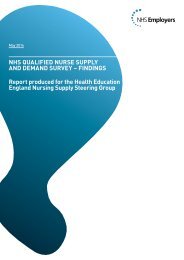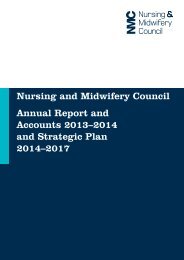Journal_1_2014_final_WEB
Journal_1_2014_final_WEB
Journal_1_2014_final_WEB
You also want an ePaper? Increase the reach of your titles
YUMPU automatically turns print PDFs into web optimized ePapers that Google loves.
Science, Practice and Education<br />
Nutrition Screening<br />
Unless the patient has a terminal illness, undernutrition is<br />
a reversible risk factor for pressure ulcer development and<br />
early identification and management is therefore critical.<br />
Individuals at risk for wounds like pressure ulcers are often<br />
also in danger of undernutrition, so nutritional screening<br />
should be completed in such cases. 2,27 Healthcare<br />
organisations should have a policy on nutrition screening<br />
and its frequency. Since individuals frequently move from<br />
one health care setting to another, the screening results<br />
must be documented and communicated from one care<br />
setting to another. 2,28 Screening tools should be quick,<br />
easy to use, validated, and reliable for the patient population<br />
served. 29 Validated screening tools are widely used in<br />
Europe. In a cross-sectional study by Langkamp-Henken<br />
et al., the Mini-Nutritional Assessment (MNA) and the<br />
MNA short form (SF) were noted to have an advantage<br />
over the use of visceral protein when screening and assessing<br />
nutritional status. 30,31 The MNA-SF, which was<br />
revised to six questions and re-validated for adults 65 and<br />
older, has 80% sensitivity and specificity and 97% positive<br />
predictive value according to clinical status. 32 The Malnutrition<br />
Screening Tool (MUST) has been validated in<br />
acute care, long-term care, and the community setting,<br />
and identifies individuals who are underweight or at risk<br />
for undernutrition. 33<br />
When the screening tool indicates nutritional deficits,<br />
timely referral to the appropriate professionals is critical.<br />
The nutrition assessment should be completed by a<br />
registered dietician who collaborates and communicates<br />
with other members of the healthcare team, including the<br />
speech therapist who is responsible for screening, evaluating,<br />
and treating swallowing problems; the occupational<br />
therapist who works to strengthen the patient’s ability to<br />
feed themselves; and the nursing staff, whose responsibilities<br />
include monitoring the patient’s acceptance of nutrition.<br />
The physician is responsible for the overall care of<br />
the patient and ordering any treatments recommended<br />
by the team.<br />
Nutrition Assessment<br />
The in-depth nutrition assessment that is performed in<br />
individuals with a screening result that points towards<br />
undernutrition is a methodical process of obtaining and<br />
interpreting data in order to make decisions about the<br />
basis of nutrition-related problems. The assessment includes<br />
interpretation and analysis of medical, nutritional,<br />
and biochemical data and food-medication interactions;<br />
obtaining anthropometric measurements; and evaluation<br />
of visual signs of poor nutrition, such as oral status, chewing/swallowing<br />
ability, and/or diminished ability to eat<br />
independently. 1<br />
Diet History: The diet history includes consultation with<br />
the patient and/or caregivers to determine the type, quantity,<br />
and frequency of food normally consumed by the<br />
patient. One should consider any factors that may influence<br />
the patients’ decision about nutrition.<br />
Nutrition-Focused Clinical Examination: The interdisciplinary<br />
team, including the dietician, should examine the<br />
individual for physical signs of undernutrition and protein<br />
depletion, as evidenced by changes in the hair, skin, or<br />
nails such as thin, dry hair, cracked lips, or brittle nails.<br />
Individuals with missing or decayed teeth or ill-fitting<br />
dentures often reduce their intake of protein foods that are<br />
difficult to chew, thus restricting their caloric intake and<br />
increasing the chance for weight loss. Moreover, individuals<br />
with swallowing problems or dysphagia may become<br />
dehydrated, lose weight, and develop pressure ulcers. Loss<br />
of dexterity and/or the ability to self-feed is a risk factor<br />
that often results in poor oral intake. All of these conditions<br />
negatively affect wound healing.<br />
Anthropometrics: Anthropometric measurements include<br />
height, weight, and body mass index (BMI). Obtaining<br />
an accurate height and weight is important, because these<br />
values are the basis for calculating body mass index (BMI)<br />
and caloric requirements.<br />
Individuals should be weighed on a calibrated scale, at<br />
the same time of the day, and wearing the same amount of<br />
clothing. Specialty beds often are equipped with a device<br />
to weigh an immobile individual. Significant weight loss<br />
places an individual at increased nutritional risk and has<br />
a negative effect on wound healing. Several studies support<br />
the theory that unintentional weight loss of 5% in<br />
30 days or 10% in 180 days is a predictor of mortality in<br />
the elderly. 34-37 Moreover, an obese patient is also at risk<br />
for PU development and healing may also be delayed in<br />
such patients when the diet consumed is inadequate in<br />
nutrients including protein.<br />
Biochemical Data: Analysis of current laboratory values<br />
is one component of the nutrition assessment, but not a<br />
very important one. Biochemical assessment data must be<br />
used with caution because values can be affected by hydration,<br />
medication, and changes in metabolism. There is no<br />
single specific laboratory test that can expressly determine<br />
an individual’s nutritional status. Serum levels of hepatic<br />
proteins including albumin, prealbumin (transthyretin),<br />
and transferrin may not correlate with the clinical observation<br />
of nutritional status. 38 In fact, studies indicate that<br />
hepatic proteins correlate with the severity of illness rather<br />
than with nutritional status. 39-41<br />
<br />
EWMA <strong>Journal</strong> <strong>2014</strong> vol 14 no 1 33




